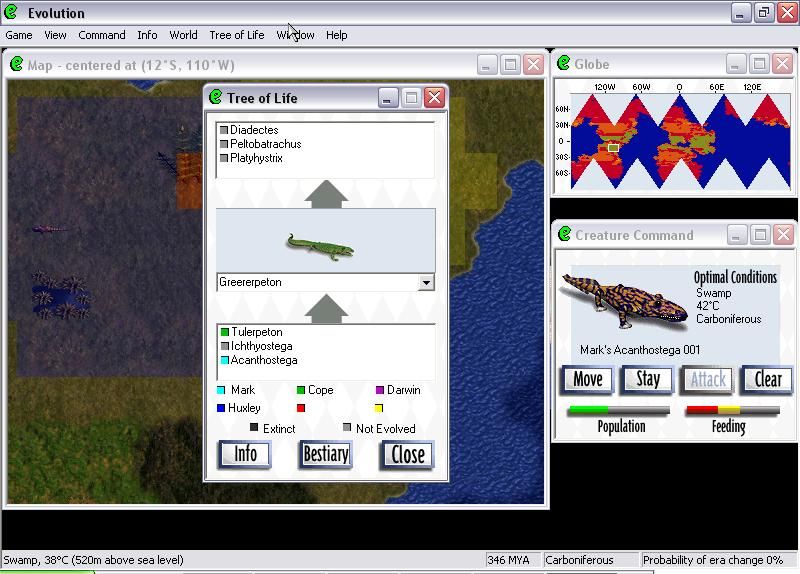Retro Replay Review
Gameplay
Evolution: The Game of Intelligent Life challenges players to shepherd a humble tetrapod through hundreds of millions of years of Earth’s history. At its core, the game feels like a hybrid of Civilization’s grand strategy and SimEarth’s planetary simulation. You begin in the primordial swamps, guiding your creature to reproduce, adapt, and colonize new environments. Resource management plays a critical role as you balance food intake, habitat needs, and predation risk. The pacing encourages careful planning: one wrong move can stunt your species’ development or leave you vulnerable to extinction.
(HEY YOU!! We hope you enjoy! We try not to run ads. So basically, this is a very expensive hobby running this site. Please consider joining us for updates, forums, and more. Network w/ us to make some cash or friends while retro gaming, and you can win some free retro games for posting. Okay, carry on 👍)
One of the game’s most compelling features is its dynamic world map. Continental drift continually alters coastlines and climate zones, forcing you to rethink migration routes and survival strategies. Geological catastrophes—ranging from massive volcanic eruptions to asteroid impacts—strike at semi-random intervals. These events provide an exhilarating sense of unpredictability, reminding players that nature’s whims can upend even the best-laid plans. As your species evolves, you unlock new traits: hardened armor, advanced sensory organs, or increased fertility, all of which can mean the difference between extinction and dominance.
Beyond the full campaign, shorter scenarios let you focus on distinct eras: the Paleozoic, Mesozoic, or Cenozoic. Whether you’re guiding a trilobite through the Cambrian explosion or helping early mammals recover after the dinosaur extinction, each scenario offers a bite-sized but richly detailed evolutionary sandbox. These chapters deliver focused challenges that highlight specific gameplay mechanics without requiring a full playthrough, making them ideal for newcomers or those pressed for time.
Graphics
While Evolution: The Game of Intelligent Life was released in the mid-1990s and doesn’t boast today’s high-definition visuals, its sprite-based design has a distinctive charm. Maps are rendered in a top-down view with clear biomes—lush green forests, arid deserts, icy tundras—each easily identifiable and important for strategic movement. Species icons are relatively simple but communicate care: from amphibious shapes of your earliest tetrapods to more elaborate reptilian or mammalian avatars as you unlock new evolutionary branches.
Animations are minimal but functional. Watching your creatures migrate in herds, feed, and occasionally fall victim to predators reminds you that life on Earth is both beautiful and brutal. Environmental changes are visually represented by shifting coloration on the map—oceans recede, mountains rise, and new landmasses appear—giving a tangible sense of the planet’s constant flux. Though the color palette may feel dated by modern standards, it remains sufficiently distinct to keep players oriented and engaged.
Interface design leans heavily on menus and statistical readouts, reflecting the game’s emphasis on data-driven decision making. Tooltips and icons explain genetic traits, food chains, and catastrophe likelihoods, but newcomers may need time to familiarize themselves with the extensive information. For strategy enthusiasts who appreciate clarity over flashy graphics, the interface delivers all the necessary details without overwhelming the screen with extraneous art or effects.
Story
Evolution doesn’t follow a traditional narrative with characters or dialogue. Instead, its story emerges organically from the interactions between your species, environmental pressures, and random events. Each playthrough becomes a unique saga—your tetrapods might rise into a dominant dinosaur analog or branch out into intelligent mammals bearing no resemblance to Homo sapiens. The tale is yours to write through the choices you make and the adaptation paths you pursue.
The geological catastrophes and era shifts serve as dramatic plot twists, punctuating long periods of gradual growth with sudden crises. A meteor strike at the end of the Mesozoic not only wipes out competing dinosaur lineages but opens ecological niches for your survivors to exploit. These large-scale events give a strong sense of progression, from simple pond dwellers to a civilization-building species whose cognitive abilities can rival humanity’s. It’s a sandbox story, but one imbued with the real drama of life’s struggle for survival.
Shorter scenarios provide more focused narratives: guide a brachiopod through the Devonian reef wars or help mammals scramble for dominance in a post-impact world. These vignettes emphasize particular evolutionary milestones and ecological challenges, creating self-contained stories that highlight the game’s educational underpinnings. While there’s no voice acting or scripted cutscenes, the emergent storytelling captures the awe and unpredictability of Earth’s evolutionary journey.
Overall Experience
Evolution: The Game of Intelligent Life is a deep, thought-provoking strategy title that rewards patience and curiosity. Its blend of simulation, strategy, and emergent storytelling offers a unique gaming experience—one that feels as much like conducting a scientific experiment as waging a war. The learning curve can be steep, especially given the layers of mechanics governing genetics, climate, and continental drift, but the payoff is a truly personalized saga of life on Earth.
For history buffs, biology enthusiasts, and strategy gamers alike, Evolution offers hours of replayability. The semi-random catastrophes keep each session fresh, while the branching evolutionary tree encourages experimentation with different trait combinations. The ability to shape ecosystems, wrestle with extinction events, and ultimately spark the rise of an intelligent species gives the game an epic scope that few other titles can match.
While its dated graphics and complex interface may deter casual players, those willing to invest time in mastering its systems will find Evolution: The Game of Intelligent Life a rewarding and enlightening journey. It’s more than a game—it’s a virtual laboratory where you can rewrite the history of life and discover the delicate balance that makes intelligence possible. For anyone intrigued by Earth’s past or the mechanics of evolution, this title remains a compelling classic worth exploring.
 Retro Replay Retro Replay gaming reviews, news, emulation, geek stuff and more!
Retro Replay Retro Replay gaming reviews, news, emulation, geek stuff and more!









Reviews
There are no reviews yet.